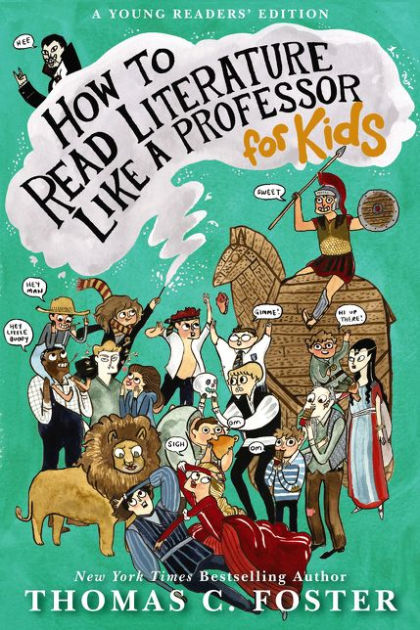How to Read Literature Like a Professor: Unveil Secrets

In “How to Read Literature Like a Professor,” readers learn how to analyze and interpret literature effectively. This blog post provides a concise and accurate answer to the question, guiding readers through the book’s key concepts and techniques.
By understanding the principles outlined in this influential work, readers can gain a deeper appreciation for literature and uncover hidden meanings within the texts they encounter. Whether you’re a student studying literature or a passionate reader looking to enhance your understanding, this blog post will offer valuable insights and tips to help you read literature like a professor.
So, let’s dive into the fascinating world of literary analysis and discover the tools that will unlock the secrets of great works of literature.
The Gateway To Deeper Understanding
Reading literature is not just about understanding the plot, characters, and setting. It is about analyzing the deeper meanings and messages that the author conveys through his work. How to Read Literature Like a Professor by Thomas C. Foster is a book that can help readers unlock the hidden meanings in literature. It is a gateway to a deeper understanding of the literary works.
Symbols In Literature
Symbols are powerful tools that authors use to convey their messages. They can be objects, actions, or even characters that represent something beyond their literal meaning. For instance, the green light in The Great Gatsby represents the unattainable American Dream. Understanding the symbols in a literary work can help readers comprehend the themes and motifs in the story. It can also help readers appreciate the complexities of the author’s message.
Themes Beyond The Surface
Themes are the underlying messages that authors want to convey through their work. They are the big ideas that the author wants readers to think about. Sometimes, these themes are not explicitly stated in the text, but readers can infer them through careful analysis of the plot, characters, and symbols. For example, the theme of love and sacrifice in The Fault in Our Stars is not directly stated, but readers can infer it from the actions and dialogue of the characters. Understanding the themes in a literary work can help readers appreciate the deeper meanings and messages in the story.
In conclusion, How to Read Literature Like a Professor is an excellent tool for readers who want to unlock the hidden meanings in literary works. By analyzing symbols, themes, and motifs, readers can gain a deeper understanding of the author’s message. It is a must-read for anyone who wants to take their reading experience to the next level.

Credit: www.amazon.com
Characters: More Than Meets The Eye
Archetypes And Their Roles
Characters in literature often represent archetypes with specific roles.
Character Development And Reader’s Insight
Character development provides insight into the story for readers.
Setting The Scene
When it comes to analyzing literature, understanding the setting is crucial. It sets the stage for the story, shapes the characters’ experiences, and influences the overall meaning of the narrative. In the book “How to Read Literature Like a Professor” by Thomas C. Foster, the author emphasizes the importance of paying attention to the setting in order to fully grasp the deeper layers of a literary work. Under the subheading of “Setting the Scene,” two key aspects to consider are the significance of time and place, as well as the atmosphere and how it sets the emotional tone of the story.
The Significance Of Time And Place
The time and place in which a story unfolds can greatly impact its meaning and interpretation. Foster explains that understanding the historical, cultural, and social context of a literary work helps readers grasp the symbolism and themes embedded within the narrative. By analyzing the time and place, readers can uncover connections to real-world events, gain insights into the characters’ motivations, and better appreciate the author’s intent.
Atmosphere: Setting The Emotional Tone
Another important element of setting is the atmosphere, which refers to the overall emotional tone created by the physical surroundings. Foster suggests that the atmosphere can reveal underlying emotions, foreshadow events, and enhance the mood of the story. Whether it’s a gloomy and foreboding landscape or a vibrant and lively city, the atmosphere plays a significant role in shaping the reader’s experience and understanding of the narrative.
By paying close attention to the time, place, and atmosphere, readers can delve deeper into the meaning and symbolism of a literary work. These elements provide valuable insights into the characters’ experiences, the author’s intentions, and the overall message of the story. So, the next time you pick up a book, remember to set the scene in your mind and let the setting guide you through the rich layers of the narrative.

Credit: www.barnesandnoble.com
Plot Twists And Narrative Devices
Reading literature is not just about enjoying the story, it’s about understanding the techniques the author uses to create that story. In How to Read Literature Like a Professor, author Thomas C. Foster explains how plot twists and narrative devices can be used to keep readers engaged and entertained. Here, we’ll focus on two important narrative devices: foreshadowing and irony.
Foreshadowing: Hints Of What’s To Come
Foreshadowing is a literary device where an author drops subtle hints about what will happen later in the story. These hints can be obvious or very subtle, and can be used to create suspense or anticipation in the reader. For example, in J.K. Rowling’s Harry Potter series, the author uses foreshadowing to hint at the final outcome of the story. The first book in the series, Harry Potter and the Philosopher’s Stone, introduces the concept of the Sorcerer’s Stone, which becomes a crucial plot point in the final book.
| Examples of Foreshadowing: | Explanation: |
|---|---|
| The mention of a gun in act one of a play | Indicates a violent confrontation later in the story |
| A character mentioning their fear of heights | Indicates that the character will face a situation involving heights later in the story |
Irony: The Unexpected Teacher
Irony is a literary device where the opposite of what is expected happens. Irony can be used to create humor, emphasize a point, or to show the contrast between what is expected and what actually happens. For example, in William Shakespeare’s play Romeo and Juliet, the audience knows that Juliet is not really dead, but Romeo does not. This creates a sense of dramatic irony that adds to the tension and emotion of the scene.
- Verbal Irony: When someone says the opposite of what they mean
- Situational Irony: When the opposite of what is expected happens
- Dramatic Irony: When the audience knows something the characters do not
Overall, understanding the plot twists and narrative devices used by authors can help readers gain a deeper appreciation for literature. By paying attention to foreshadowing and irony, readers can better understand the motivations of characters and the themes of the story.
The Role Of Conflict
When it comes to understanding the depths of literature, one cannot overlook the pivotal role of conflict. In the book “How to Read Literature Like a Professor” by Thomas C. Foster, the exploration of conflict is a crucial aspect. Let’s delve into the significance of conflict and its various dimensions within literature.
Internal Vs. External Conflicts
Internal conflicts occur within a character’s mind or heart, shaping their decisions and actions. On the other hand, external conflicts manifest as struggles with outside forces such as nature, society, or other characters. Both types of conflict contribute to the development and complexity of characters and plots in literature.
Conflict As A Catalyst For Change
Conflict serves as a catalyst for change within the narrative, driving character development and plot progression. It propels characters out of their comfort zones and compels them to confront challenges, leading to transformative experiences. This evolution adds depth and resonance to the storytelling, captivating readers and offering profound insights.
Symbolism And Metaphor
In literature, symbolism and metaphor are powerful tools that authors use to convey deeper meaning and enhance the reader’s understanding of a story. By decoding symbols and recognizing metaphors, readers can delve into the hidden layers of a text and uncover a wealth of hidden messages and themes.
Decoding Symbols For Deeper Meaning
Symbols are objects, characters, or elements within a story that represent something beyond their literal meaning. They can be tangible, such as a rose symbolizing love, or abstract, like a storm representing turmoil. Decoding symbols requires careful analysis and an understanding of the author’s intentions.
When reading literature, pay attention to recurring motifs or objects that seem to carry significance. These symbols can provide insights into the story’s themes, characters, or even historical or cultural contexts. For example, the green light in F. Scott Fitzgerald’s “The Great Gatsby” symbolizes the unattainable American Dream.
By recognizing and interpreting symbols, readers can unravel hidden meanings and gain a deeper appreciation for the author’s craft. Symbolism adds depth and complexity to a story, inviting readers to engage with the text on multiple levels.
Metaphors: Connecting The Dots
Metaphors, on the other hand, are figures of speech that compare two unrelated things, highlighting their similarities to create vivid imagery and evoke emotions. They allow readers to make connections and understand abstract concepts in a more concrete way.
When encountering a metaphor, look for the object or idea being compared and the characteristics they share. Metaphors often use words like “is” or “are” to establish the connection. For example, when Shakespeare’s Juliet says, “But soft! What light through yonder window breaks? It is the east, and Juliet is the sun,” the metaphor compares Juliet to the sun, emphasizing her beauty and radiance.
Metaphors enable readers to see the world from a fresh perspective and engage with the text on a deeper emotional level. They enrich the reading experience by adding layers of meaning and creating a more vivid and memorable narrative.
Themes And Motifs
Understanding themes and motifs is crucial in analyzing literature. By exploring universal themes, readers can uncover deeper meanings within the text. Recurring motifs hold significant symbolism that enhances the overall narrative.
Exploring Universal Themes
- Themes like love, power, and redemption resonate across cultures.
- Universal themes convey fundamental truths about the human experience.
- They provide insight into the author’s message and societal values.
Recurring Motifs And Their Significance
- Motifs are symbols or patterns that repeat throughout a story.
- They add layers of meaning and reinforce central themes.
- Analyzing motifs enhances comprehension and reveals hidden messages.

Credit: www.target.com
Critical Reading Strategies
Critical Reading Strategies are essential for understanding literature deeply. By employing these strategies, readers can uncover layers of meaning and symbolism within texts.
Asking The Right Questions
Ask questions about character motives, symbolism, and themes to delve into the text’s deeper meanings.
Connecting Literature To Life
Relate the literary work to real-life situations and experiences to gain a better understanding of its significance.
Frequently Asked Questions
What Is The Significance Of The Book “how To Read Literature Like A Professor”?
“How to Read Literature Like a Professor” helps readers understand the deeper meanings and symbols in literature. It provides insightful analysis, enhancing the reading experience by uncovering layers of symbolism and themes within literary works.
How Can This Book Improve My Understanding Of Literature?
This book offers valuable insights into the techniques and devices commonly used in literature, enabling readers to recognize and interpret these elements. By applying the principles outlined in the book, readers can gain a deeper understanding of literary works and appreciate the complexities within them.
What Makes “how To Read Literature Like A Professor” A Valuable Resource For Readers?
This book serves as an indispensable guide, equipping readers with the tools to analyze and interpret literature effectively. It empowers readers to engage with texts on a deeper level, fostering a richer and more rewarding reading experience.
Can “how To Read Literature Like A Professor” Benefit Aspiring Writers?
Yes, this book provides aspiring writers with a wealth of knowledge on literary techniques and storytelling devices. By gaining a deeper understanding of literature through this book, writers can enhance their own craft and develop a more nuanced approach to storytelling.
Conclusion
In essence, learning to read literature like a professor opens up a whole new world of understanding and interpretation. It allows us to delve deeper into the hidden meanings and symbolism within literary works, enriching our overall reading experience. By applying the principles discussed, we can enhance our ability to appreciate and analyze literature on a whole new level.





